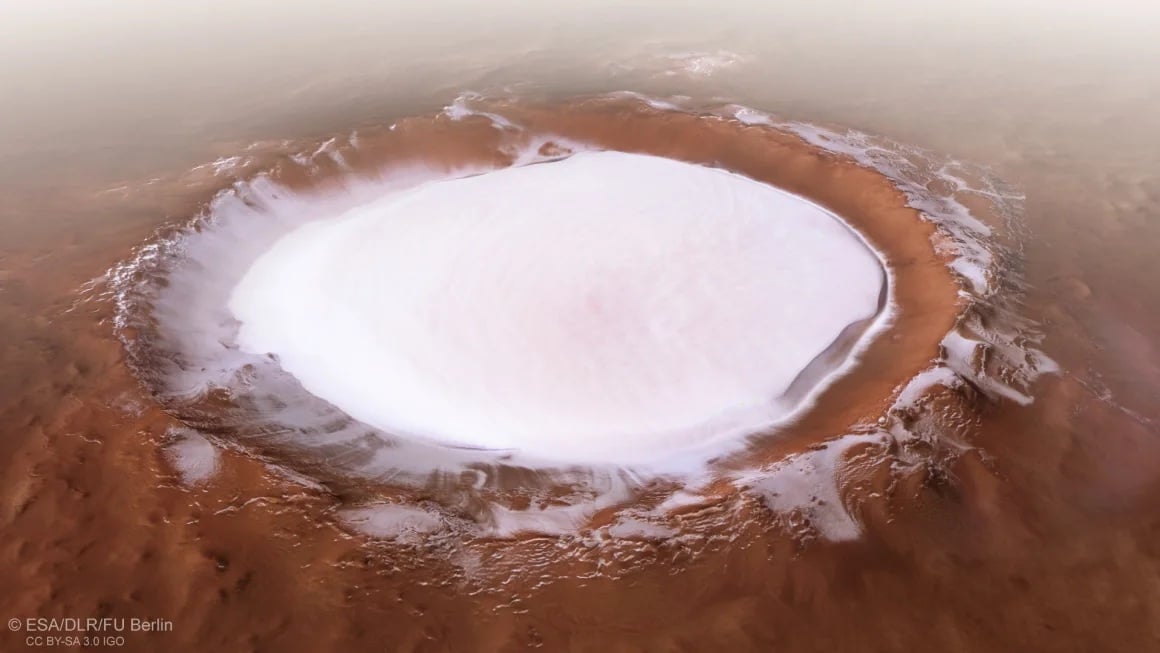Science
New Research Reveals Ice Deposits Hold Mars’ Climate History

Recent research indicates that ice deposits within Martian craters may provide crucial insights into the planet’s climatic history. A team of Japanese scientists, led by Trishit Ruj from the Institute for Planetary Materials at Okayama University, has discovered that these ice layers serve as a record of Mars’ past, revealing that the planet underwent multiple ice ages over hundreds of millions of years. This study, published in the journal Geology, could reshape our understanding of Martian climate evolution and offer practical applications for future exploration.
The surface of Mars is marked by various geological features that hint at a time when the planet was warmer and wetter, supporting rivers, lakes, and a vast ocean in its northern hemisphere. Evidence of this past includes river channels, delta fans, and clay-rich sedimentary deposits. Understanding the extent and duration of water on Mars, as well as the factors leading to its current arid state, has been an ongoing pursuit for scientists over the past half-century.
The research team focused on glacial landforms preserved in craters located between 20°N and 45°N latitude. Using high-resolution images from the Mars Reconnaissance Orbiter, they identified craters exhibiting signs of glaciation, such as ridges and maze-like pit formations. Their findings revealed that ice consistently accumulated in the shadowed southwestern walls of these craters, a pattern that persisted throughout multiple glacial periods during the Amazonian period, which dates from approximately 640 to 98 million years ago.
Dr. Ruj explained, “Like Earth, shifts in Mars’ climate were driven by changes in the planet’s axial tilt, or obliquity.” Mars’ axial tilt varies significantly over geological timescales, which has influenced the planet’s climate, triggering cycles of glaciation and thawing that gradually reduced its ice deposits. This ongoing process highlights how Mars has transitioned to its current cold, dry state.
The implications of this research extend beyond planetary science. As humanity prepares for potential crewed missions to Mars, understanding the distribution of water ice will be vital for sustaining astronauts. In-situ resource utilization (ISRU) will be crucial, as spacecraft take between six to nine months to travel from Earth to Mars using conventional propulsion systems. Water ice could be converted into drinking water, oxygen, and even fuel for return trips.
Moreover, the techniques and tools used to analyze Martian climates may also prove beneficial on Earth. With climate change leading to the rapid melting of glaciers and ice caps, the modeling methods developed for Mars could help scientists monitor changes in Earth’s frozen landscapes.
Dr. Hasegawa from Kochi University emphasized the broader significance of this research, stating, “Mars serves as a natural laboratory for understanding how ice behaves over vast timescales. The insights we gain here can sharpen our understanding of climate processes on Earth as well.”
The study not only enhances our understanding of Mars but also serves as a reminder of the interconnectedness of planetary science and Earth-based environmental challenges. As researchers continue to explore the Red Planet, the knowledge gained may provide critical insights for both future exploration and current global climate issues.
-

 Science2 weeks ago
Science2 weeks agoIROS 2025 to Showcase Cutting-Edge Robotics Innovations in China
-

 Politics2 weeks ago
Politics2 weeks agoJudge Considers Dismissal of Chelsea Housing Case Citing AI Flaws
-

 World2 weeks ago
World2 weeks agoBravo Company Veterans Honored with Bronze Medals After 56 Years
-

 Lifestyle2 weeks ago
Lifestyle2 weeks agoStone Island’s Logo Worn by Extremists Sparks Brand Dilemma
-

 Top Stories2 weeks ago
Top Stories2 weeks agoIndonesia Suspends 27,000 Bank Accounts in Online Gambling Crackdown
-

 Health2 weeks ago
Health2 weeks agoStartup Liberate Bio Secures $31 Million for Next-Gen Therapies
-

 Sports2 weeks ago
Sports2 weeks agoMel Kiper Jr. Reveals Top 25 Prospects for 2026 NFL Draft
-

 Health2 weeks ago
Health2 weeks agoTop Hyaluronic Acid Serums for Radiant Skin in 2025
-

 World2 weeks ago
World2 weeks agoHoneywell Predicts Record Demand for Business Jets Over Next Decade
-

 Politics2 weeks ago
Politics2 weeks agoNew Jersey Voters Urged to Register Ahead of November Election
-

 Lifestyle2 weeks ago
Lifestyle2 weeks agoMary Morgan Jackson Crowned Little Miss National Peanut Festival 2025
-

 Sports2 weeks ago
Sports2 weeks agoYamamoto’s Mastery Leads Dodgers to 5-1 Victory in NLCS Game 2









